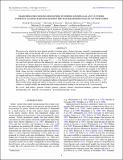| dc.contributor.author | Blanchard, Peter K. | |
| dc.contributor.author | Bayliss, Matthew B. | |
| dc.contributor.author | McDonald, Michael A. | |
| dc.contributor.author | Dahle, Hakon | |
| dc.contributor.author | Gladders, Michael D. | |
| dc.contributor.author | Sharon, Keren | |
| dc.contributor.author | Mushotzky, Richard F. | |
| dc.date.accessioned | 2015-02-12T17:59:15Z | |
| dc.date.available | 2015-02-12T17:59:15Z | |
| dc.date.issued | 2013-07 | |
| dc.date.submitted | 2013-01 | |
| dc.identifier.issn | 0004-637X | |
| dc.identifier.issn | 1538-4357 | |
| dc.identifier.uri | http://hdl.handle.net/1721.1/94496 | |
| dc.description.abstract | The process by which the mass density profile of certain galaxy clusters becomes centrally concentrated enough to produce high strong lensing (SL) cross-sections is not well understood. It has been suggested that the baryonic condensation of the intracluster medium (ICM) due to cooling may drag dark matter to the cores and thus steepen the profile. In this work, we search for evidence of ongoing ICM cooling in the first large, well-defined sample of SL selected galaxy clusters in the range 0.1 < z < 0.6. Based on known correlations between the ICM cooling rate and both optical emission line luminosity and star formation, we measure, for a sample of 89 SL clusters, the fraction of clusters that have [O II]λλ3727 emission in their brightest cluster galaxy (BCG). We find that the fraction of line-emitting BCGs is constant as a function of redshift for z > 0.2 and shows no statistically significant deviation from the total cluster population. Specific star formation rates, as traced by the strength of the 4000 Å break, D [subscript 4000], are also consistent with the general cluster population. Finally, we use optical imaging of the SL clusters to measure the angular separation, R [subscript arc], between the arc and the center of mass of each lensing cluster in our sample and test for evidence of changing [O II] emission and D [subscript 4000] as a function of R [subscript arc], a proxy observable for SL cross-sections. D [subscript 4000] is constant with all values of R [subscript arc], and the [O II] emission fractions show no dependence on R [subscript arc[ for R [subscript arc] > 10'' and only very marginal evidence of increased weak [O II] emission for systems with R [subscript arc] < 10''. These results argue against the ability of baryonic cooling associated with cool core activity in the cores of galaxy clusters to strongly modify the underlying dark matter potential, leading to an increase in SL cross-sections. | en_US |
| dc.description.sponsorship | National Science Foundation (U.S.) (Research Experiences for Undergraduates (REU)) | en_US |
| dc.description.sponsorship | United States. Dept. of Defense (Awards to Stimulate and Support Undergraduate Research Experiences (ASSURE) program, grant number 0754568) | en_US |
| dc.description.sponsorship | Smithsonian Institution | en_US |
| dc.description.sponsorship | National Science Foundation (U.S.) (NSF Astronomy Division, grant number AST-1009012) | en_US |
| dc.description.sponsorship | Space Telescope Science Institute (U.S.) (Hubble Fellowship grant) | en_US |
| dc.description.sponsorship | Research Corporation for Science Advancement (Cottrell Scholar Award) | en_US |
| dc.language.iso | en_US | |
| dc.publisher | Institute of Physics/American Astronomical Society | en_US |
| dc.relation.isversionof | http://dx.doi.org/10.1088/0004-637X/772/1/24 | en_US |
| dc.rights | Article is made available in accordance with the publisher's policy and may be subject to US copyright law. Please refer to the publisher's site for terms of use. | en_US |
| dc.source | American Astronomical Society | en_US |
| dc.title | SEARCHING FOR COOLING SIGNATURES IN STRONG LENSING GALAXY CLUSTERS: EVIDENCE AGAINST BARYONS SHAPING THE MATTER DISTRIBUTION IN CLUSTER CORES | en_US |
| dc.type | Article | en_US |
| dc.identifier.citation | Blanchard, Peter K., Matthew B. Bayliss, Michael McDonald, Hakon Dahle, Michael D. Gladders, Keren Sharon, and Richard Mushotzky. “SEARCHING FOR COOLING SIGNATURES IN STRONG LENSING GALAXY CLUSTERS: EVIDENCE AGAINST BARYONS SHAPING THE MATTER DISTRIBUTION IN CLUSTER CORES.” The Astrophysical Journal 772, no. 1 (July 2, 2013): 24. © 2013 American Astronomical Society. | en_US |
| dc.contributor.department | MIT Kavli Institute for Astrophysics and Space Research | en_US |
| dc.contributor.mitauthor | McDonald, Michael A. | en_US |
| dc.relation.journal | Astrophysical Journal | en_US |
| dc.eprint.version | Final published version | en_US |
| dc.type.uri | http://purl.org/eprint/type/JournalArticle | en_US |
| eprint.status | http://purl.org/eprint/status/PeerReviewed | en_US |
| dspace.orderedauthors | Blanchard, Peter K.; Bayliss, Matthew B.; McDonald, Michael; Dahle, Håkon; Gladders, Michael D.; Sharon, Keren; Mushotzky, Richard | en_US |
| mit.license | PUBLISHER_POLICY | en_US |
| mit.metadata.status | Complete | |
